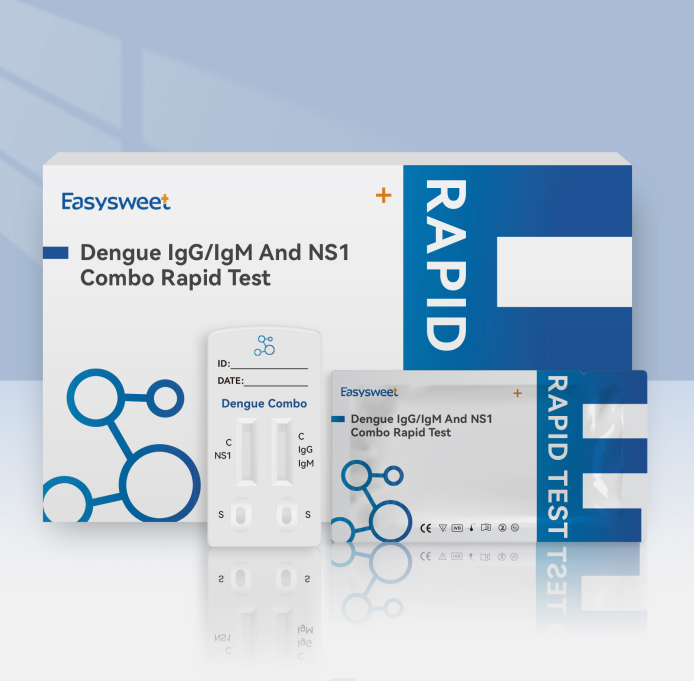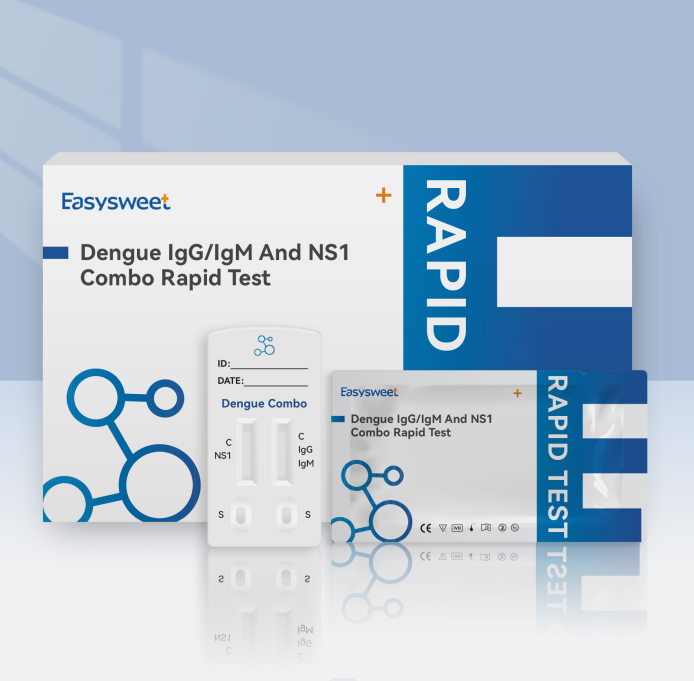Dengue fever is a flavivirus transmitted by Aedes aegypti and Aedes albopictus. It is widely distributed in tropical and subtropical regions of the world, infecting as many as 100 million people each year. Dengue infection is characterized by sudden onset of fever, severe headache, myalgia, arthralgia, and rash.
Primary dengue infection results in an increase in IgM antibodies to detectable levels within 3 to 5 days of onset of fever. IgM antibodies usually last 30 to 90 days. 3 Most dengue patients in endemic areas have secondary infections resulting in high levels of specific IgG antibodies preceding or concurrent with IgM responses. Therefore, detection of specific anti-dengue IgM and IgG antibodies also helps to differentiate primary from secondary infection.

NS1 is one of seven dengue virus nonstructural proteins thought to be involved in viral replication. NS1 exists as a monomer in its immature form, but is rapidly processed in the endoplasmic reticulum to form a stable dimer. Small amounts of NS1 remain associated with intracellular organelles, which are believed to be involved in viral replication. The remainder of NS1 is either associated with the plasma membrane or secreted as a soluble hexamer. NS1 is critical to viral viability, but its exact biological function is unknown. Antibodies produced in response to NS1 during viral infection can cross-react with cell surface antigens on epithelial cells and platelets, which has been implicated in the development of DHF.
The Easysweet Dengue IgG/IgM And NS1 Combo Rapid Test (Whole Blood/Serum/Plasma) is a rapid test that utilizes a combination of dengue antigen-coated colored particles to detect IgG and IgM Dengue in human whole blood, serum or plasma Antibody. It utilizes a combination of colored particles coated with dengue antibodies to detect the dengue NS1 antigen in human whole blood, serum, or plasma.
principle
The Easysweet Dengue IgG/IgM And NS1 Combo Rapid Test (Whole Blood/Serum/Plasma) is a qualitative membrane-based immunoassay for the detection of dengue antibodies in whole blood, serum, or plasma. The test consists of two components, an IgG component and an IgM component. In the IgG component, anti-human IgG is coated in the IgG detection line area. During the test, the sample reacts with dengue antigen-coated particles in the test cartridge. The mixture then migrates up the membrane chromatography by capillary action and reacts with anti-human IgG in the area of the IgG test line. If the specimen contains dengue IgG antibodies, a colored line will appear in the IgG test line area. In the IgM component, anti-human IgM is coated in the IgM detection line region. During the test, the sample reacts with anti-human IgM. Dengue IgM antibody, if present in the sample,
Therefore, if the specimen contains dengue IgG antibodies, a colored line will appear in the IgG test line area. If the specimen contains dengue IgM antibodies, a colored line will appear in the IgM test line area. If the specimen does not contain dengue antibodies, no colored lines will appear in either test line area, indicating a negative result. As a program control, a colored line always appears in the control line area, indicating that the appropriate volume of sample has been added and that membrane wicking has occurred.
If there is any infringement, please contact us.


